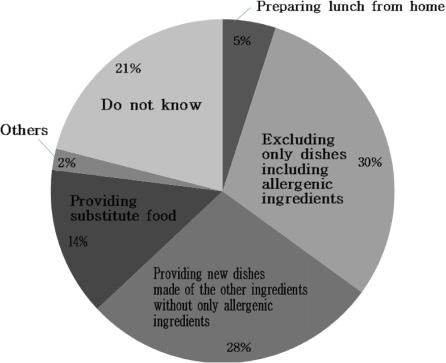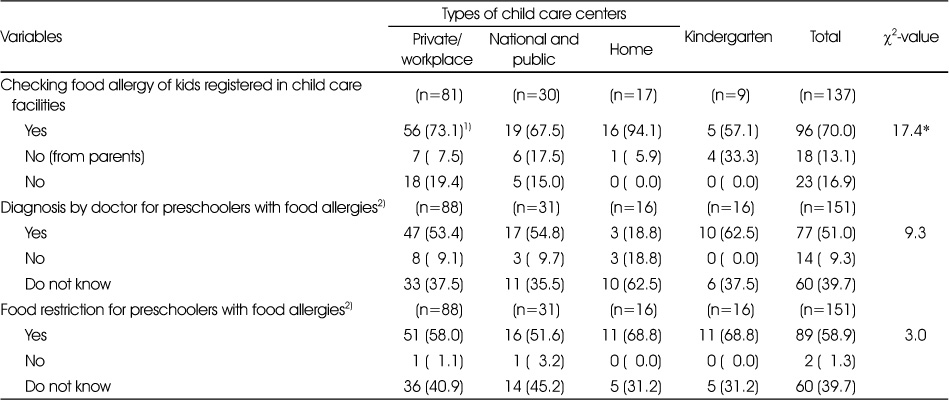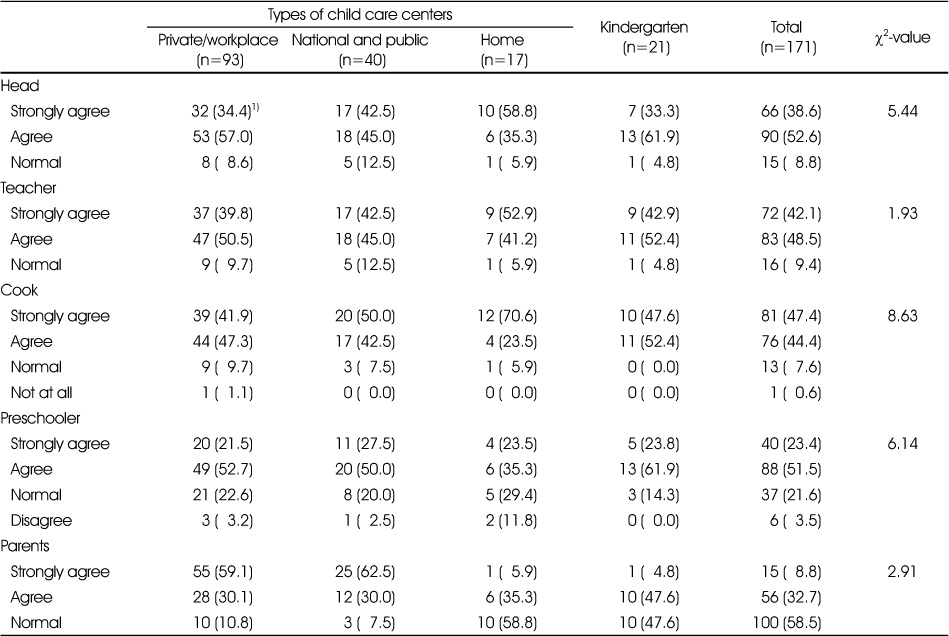Articles
- Page Path
- HOME > Korean J Community Nutr > Volume 22(4); 2017 > Article
-
Research Article
- Food Allergy Awareness and Nutritional Management by Preschooler's Faculty Members of Child Care Facilities
-
Soo Bin Kim, Jung Hee Kim

-
Korean Journal of Community Nutrition 2017;22(4):298-306.
DOI: https://doi.org/10.5720/kjcn.2017.22.4.298
Published online: August 31, 2017
Department of Food and Nutrition, College of Natural Sciences, Seoul Women's University, Seoul, Korea.
- Corresponding author: Jung Hee Kim. Department of Food and Nutrition, College of Natural Sciences, Seoul Women's University, 621 Hwarangno, Nowon-gu, Seoul 139-774, Korea. Tel: (02) 970-5646, Fax: (02) 976-4049, jheekim@swu.ac.kr
Copyright © 2017 The Korean Society of Community Nutrition
This is an Open-Access article distributed under the terms of the Creative Commons Attribution Non-Commercial License (http://creativecommons.org/licenses/by-nc/3.0/) which permits unrestricted non-commercial use, distribution, and reproduction in any medium, provided the original work is properly cited.
- 1,180 Views
- 3 Download
- 3 Crossref
Abstract
-
Objectives
- The purpose of this study was to investigate the awareness and nutritional management of food allergy (FA) by preschooler's faculty members in child care centers.
-
Methods
- A questionnaire survey was conducted among faculty members of child care centers in Seoul. The questionnaire was designed to identify the prevalence of food allergies, requirements of food allergy support and differences in food management depending on the presence of allergic diseases. After excluding incomplete responses, the data of 171 faculties in 137 child care centers (95.0%) were used for statistical analysis.
-
Results
- According to the 137 collected questionnaires, 96 child care centers asked parents about their children's allergic disease and 151 children from 66 child care centers had food allergies. A reported 89 children from 43 child care centers had food restrictions. However, 9 child care centers (21.0%) were not aware of food restriction for children with food allergies. Only 6 child care centers (14.0%) supplied substitute foods with the same amount and type of nutrients. Forty eight faculties (28.1%) received training about food allergies. Although there were some differences according to institution type, most of the faculty members wanted food allergy-related support.
-
Conclusions
- This study identified a lack of food allergy training for faculty members in child care centers. For proper management, it is necessary for faculty members of child care centers to be educated on overall food allergies. Food allergy-related support such as menus without allergenic ingredients, guidelines on emergency care for food allergies and anaphylaxis should be provided for faculty members in child care centers.
- 1. Kay AB. T Cells orchestrators of the asthmatic response. Ciba Found Symp 1997; 206: 56-67.PubMed
- 2. Ministry of Health & Welfare, Korea Centers for Disease Control and Prevention. Food allergy [internet]. Korea Centers for Disease Control and Prevention; 2015; cited 2015 Dec 21]. Available from: http://www.cdc.go.kr/CDC/contents/CdcKrContentView.jsp?cid=60092&menuIds=HOME001-MNU1130-MNU1110-MNU1600-MNU1610.
- 3. Sicherer SH, Sampson HA. Food allergy. J Allergy Clin Immunol 2010; 125: 2 Suppl. 116-125.ArticlePubMed
- 4. Chung SJ, Han YS, Chung SW, Ahn KM, Park HY, Lee SI. Marasmus and kwashiorkor by nutritional ignorance related to vegetarian diet and infants with atopic dermatitis in South Korea. Korean J Nutr 2004; 37(7): 540-549.
- 5. Han YS. Management of food allergy in the community. Food Sci Ind 2015; 48(1): 24-31.
- 6. Lim DH. Epidemiology of anaphylaxis in Korean children. Korean J Pediatr 2008; 51(4): 351-354.Article
- 7. Jang GC, Chang YS, Choi SH, Song WJ, Lee SY, Park HS. Overview of anaphylaxis in Korea: diagnosis and management. Allergy Asthma Respir Dis 2013; 1(3): 181-196.Article
- 8. Lee SY, Kim KW, Lee HH, Lim DH, Chung HL, Kim SW. Incidence and clinical characteristics of pediatric emergency department visits of children with severe food allergy. Korean J Asthma Allergy Clin Immunol 2012; 32(3): 169-175.
- 9. Allen KJ, Hill DJ, Heine RG. 4. Food allergy in childhood. Med J Aust 2006; 185(7): 394-400.ArticlePubMedPDF
- 10. Seo WH, Jang EY, Han YS, Ahn KM, Jung JT. Management of food allergies in young children at a child care center and hospital in Korean. Pediatr Allergy Respir Dis 2011; 21(1): 32-38.Article
- 11. Lee AH, Kim KE, Lee KE, Kim SH, Wang TW, Kim KW. Prevalence of food allergy and perceptions on food allergen labeling in school foodservice among Korean students. Allergy Asthma Respir Dis 2013; 1(3): 227-234.Article
- 12. Kim YG, Yu KH, Ly SY. Perception of elementary school parents in Gyeongbuk area on allergenic food labeling system and children's food allergy status. Korean J Hum Ecol 2013; 22(5): 491-506.Article
- 13. Lee HS, Hong SC, Kim JH, Kim JW, Lee KH, Lee JC. Prevalence of food allergy and the sensitization rates of food allergens in school-aged children in Jeju. Korean Public Health Res 2014; 40(3): 49-58.
- 14. Won JH. A study on the awareness and management of food allergy among nutritionist and nutrition teachers in elementary and high schools in Seoul. [master's thesis]. Sookmyung Women's University; 2015.
- 15. Kim HI. Research methods in sampling. 1st ed. Paju: Kyungmoonsa; 2014. p. 9.
- 16. Jung YH, Ko H, Kim HY, Seo JH, Kwon JW, Kim BJ. Prevalence and risk factors of food allergy in preschool children in Seoul. Korean J Asthma Allergy Clin Immunol 2011; 31(3): 177-183.
- 17. Lim Y, Oh SY. Development of a semi-quantitative food frequency questionnaire for pre-school children in Korea. Korean J Community Nutr 2002; 7(1): 58-66.
- 18. Lee Y, Kim HH, Ko YS. Perception on food allergy labelling and management of nutritional education among higher grade elementary school students in Jeju area. J Nutr Health 2015; 48(6): 530-541.Article
- 19. Kim YM, Heo YR, Ro HK. Perception and practices regarding food allergy of elementary and middle school nutritionists in the Jeonnam area. Korean J Society Food Sci Nutr 2014; 43(1): 151-161.Article
- 20. Yoon AR. A study on the state of food allergy management nutritionists and nutrition teacher in elemetary and middle schools. [master's thesis]. Inha University; 2015.
- 21. Christie L, Hine RJ, Parker JG, Burks W. Food allergies in children affect nutrient intake and growth. J Am Diet Assoc 2002; 102(11): 1648-1651.ArticlePubMed
- 22. Ahn K. Food allergy: diagnosis and management. Korean J Asthma Allergy Clin Immunol 2011; 31(3): 163-169.
- 23. Kim SB, Kim JH. Food allergy awareness and nutritional management by the parents of preschool children. Korean J Community Nutr 2016; 21(5): 426-439.ArticlePDF
- 24. Han YS, Chung SJ, Cho YY, Choi HM, Ahn KM, Lee SL. Analysis of the rate of sensitization to food allergen in children with atopic dermatitis. Korean J Community Nutr 2004; 9(1): 90-97.
- 25. Korea Ministry of Government Legislation. School meals act enforcement regulation [internet]. National Law Information Center; 2013; cited 2015 Nov 7]. Available from: http://www.law.go.kr/lsInfoP.do?lsiSeq=166408&efYd=20150101#000.
- 26. Urisu A, Ebisawa M, Ito K, Aihara Y, Ito S, Mayumi M. Japanese guideline for food allergy 2014. Allergol Int 2014; 63(3): 399-419.Article
- 27. Food Allergy Research & Education, Inc. About food allergy [internet]. Food Allergy & Anaphylaxis Network (FAAN) and the Food Allergy Initiative (FAI); 2015; cited 2015 Nov 7]. Available from: http://www.foodallergy.org/mostpopular-resources.
- 28. Centers for Disease Control and Prevention. Voluntary guidelines for managing food allergies in schools and early care and education programs. Washington, DC: US Department of Health and Human Services; 2013.
REFERENCES
Figure & Data
REFERENCES
Citations

- Knowledge and management of food allergy by parents of preschool children who experience food allergies
Seung Hui Kim, Seung-Min Lee
Journal of Nutrition and Health.2023; 56(2): 184. CrossRef - Risk factors for food allergy among children in Seoul: focusing on dietary habits and environmental factors
Mijung Jang, KyooSang Kim
Journal of Nutrition and Health.2019; 52(6): 559. CrossRef - Study on the snack menu pattern, food diversity and satisfaction of parent provided by Center for Children's Foodservice Management in Jeonbuk area
Eun-Byul Sym, Jeong-Ok Rho
Journal of Nutrition and Health.2019; 52(5): 501. CrossRef

Fig. 1
General characteristic of child care facilities and their food allergy management
1) N (%)
*: p < 0.05 by Chi-square test
Food allergy management by child care facilities
1) N (%)
2) Only corresponded ‘Yes’ or ‘No (from parents)’
*: p < 0.05 by Chi-square test
Food allergens in preschoolers reported by parents and child care facilitiess
Data are multiple responses
1) Self-reported by preschooler's parents
2) Reported by child care facilities on food allergens showing allergy symptoms whin last 12 months
3) N (%)
Symptoms of food allergy in preschoolers reported by parents and child care facilities
Data are multiple responses
1) Self-reported by preschooler's parents
2) Reported by child care facilities on food allergens showing allergy symptoms whin last 12 months
3) N (%)
Care and management of food allergies by child care facilities
1) N (%)
2) Data are multiple responses
*: p < 0.05 by Fisher's exact test since cells have expected frequency less than 5
Needs for subject-specific education on food allergy of child care facilities
1) N (%)
1) N (%) *: p < 0.05 by Chi-square test
1) N (%) 2) Only corresponded ‘Yes’ or ‘No (from parents)’ *: p < 0.05 by Chi-square test
Data are multiple responses 1) Self-reported by preschooler's parents 2) Reported by child care facilities on food allergens showing allergy symptoms whin last 12 months 3) N (%)
Data are multiple responses 1) Self-reported by preschooler's parents 2) Reported by child care facilities on food allergens showing allergy symptoms whin last 12 months 3) N (%)
1) N (%) 2) Data are multiple responses *: p < 0.05 by Fisher's exact test since cells have expected frequency less than 5
1) N (%)

 KSCN
KSCN







 Cite
Cite


